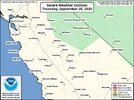Crazy storm weather in Croatia
Rain in Karlobag
In Karlovac, 48.2 millimeters (1,9 inches) of rain fell on Sunday between 0:00 and 08:00. For comparison, the average amount of precipitation in that city during July is 92 millimeters (3,6 inches). If we add to that figure Saturday's precipitation - between 08:00 and 00:00, 16.6 millimeters fell - the total amount of rain in 24 hours is slightly less than 65 millimeters (2,5 inches).
Also hail in Karlovac:
Hail in Mali Lošinj:
Lightning strikes the Thermal Power Plant in Zagreb
And the memorable scene was filmed in Istria. During a storm in Jehnići near Poreč, residents could see an incredible palette of colors in the sky while lightning flashed.
In Zadar, on Saturday between 21:00 and 22:00, 20.3 millimeters of rain fell, which is more than half of the average July precipitation in that city, which is 35.4 millimeters.
Detailed article see here (in Croatian)

 hr.sott.net
hr.sott.net
Due to the approaching high-altitude cyclone and the influx of moist, unstable air, the State Hydrometeorological Institute (DHMZ) has issued a red warning for the Zagreb, Karlovac and Rijeka regions, while the rest of the country is under an orange warning.
Severe thunderstorms, heavy rain, possible hail and a sudden drop in temperature are expected during the evening and night, the DHMZ warns.
Rain in Karlobag
In Karlovac, 48.2 millimeters (1,9 inches) of rain fell on Sunday between 0:00 and 08:00. For comparison, the average amount of precipitation in that city during July is 92 millimeters (3,6 inches). If we add to that figure Saturday's precipitation - between 08:00 and 00:00, 16.6 millimeters fell - the total amount of rain in 24 hours is slightly less than 65 millimeters (2,5 inches).
Also hail in Karlovac:
Hail in Mali Lošinj:
Lightning strikes the Thermal Power Plant in Zagreb
And the memorable scene was filmed in Istria. During a storm in Jehnići near Poreč, residents could see an incredible palette of colors in the sky while lightning flashed.
In Zadar, on Saturday between 21:00 and 22:00, 20.3 millimeters of rain fell, which is more than half of the average July precipitation in that city, which is 35.4 millimeters.
Detailed article see here (in Croatian)

Žestoko nevrijeme poharalo Hrvatsku
Najteže vremenske prilike tek se očekuju tijekom večeri i noći diljem zemlje. Snažno nevrijeme zahvatilo je u subotu poslijepodne i u večernjim satima mnoge hrvatske krajeve, a najteže vremenske prilike tek se očekuju tijekom noći. Na autocesti...












